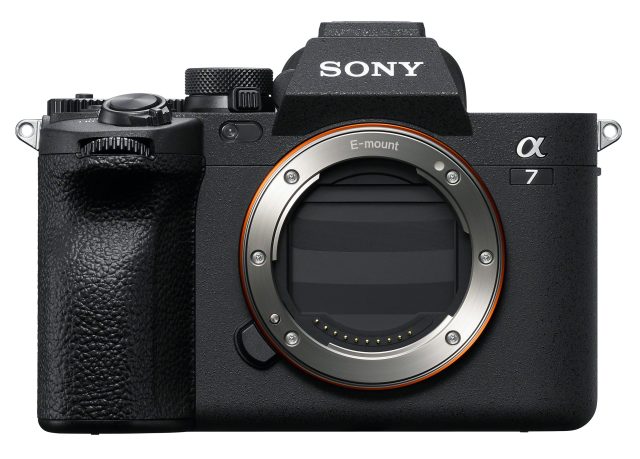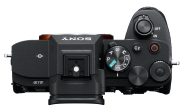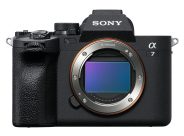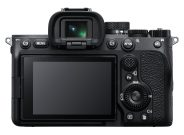Announced
Production status
System
Sony a7 IV
35mm AF digital mirrorless camera
Specification
| Format: | |
| 35mm full frame | |
Imaging sensor: | 35.9 × 23.9mm CMOS sensor |
Resolution: | 7008 × 4672 - 33 MP |
Sensor-shift image stabilization: | Yes |
| Sony E [18mm] | |
| Shutter: | |
Type: | Focal-plane |
Model: | Electronically controlled |
Speeds: | 30 - 1/8000 + B |
| Exposure: | |
Exposure metering: | Through-the-lens (TTL), open-aperture |
Exposure modes: | Programmed Auto |
| Aperture-priority Auto | |
| Shutter-priority Auto | |
| Manual | |
| Physical characteristics: | |
Weight: | 658g |
Dimensions: | 131.3x96.4x79.8mm |
Manufacturer description
San Diego, CA – October 21, 2021 - Sony Electronics Inc. today announced three new additions to its imaging line-up: the Alpha 7 IV interchangeable-lens camera (model ILCE-7M4) with a newly developed 33-megapixel (approx.,effective) full-frame image sensor, as well as two new flashes – the HVL-F60RM2 and HVL-F46RM.
The Alpha 7 IV takes “basic” to the next level for full-frame cameras with excellent image quality and performance, redefining the lofty standards set by the acclaimed Alpha 7 III. The new model features many of Sony’s most advanced imaging technologies, including the latest BIONZ XR™ processing engine and advanced AF (autofocus) capabilities from the flagship Alpha 1 combined with streamlined operability and enhanced reliability for photos and movies, making it the perfect all-around camera for today’s imaging enthusiasts and professionals. The Alpha 7 IV also boasts a 33MP (approx., effective) image resolution, rich movie expression and various features to support the growing demand for remote communication, bringing new meaning to what a “basic” camera can accomplish.
“Since its introduction over three years ago, the Alpha 7 III has made tremendous impact in our industry, completely redefining the expectations for what can be accomplished with a ‘basic’, or entry-level full-frame camera,” said Yang Cheng, Vice President, Imaging Solutions, Sony Electronics Inc. “Now, it’s time to break through all existing boundaries again. The Alpha 7 IV brings together the best of Sony imaging technologies in both photo and video to deliver a high-end experience to a wider range of customers. This gives today’s creators a new level of freedom to capture, create and share in ways that they’ve never been able to before, no matter the situation in which they find themselves.”
Alpha 7 IV: Innovation Never Ends
The new Alpha 7 IV is an exceptional hybrid camera packed with outstanding still image quality and evolved video technology with advanced autofocus, enhanced operability and improved workflow capability. The model was developed with the environment in mind by using Sony’s original recycled plastic SORPLAS™ for the camera body and packaging with recyclable[i] materials and less plastic.
Outstanding Image Quality
Thanks to a newly developed 33MP (approx., effective) full-frame back-illuminated Exmor R™ CMOS image sensor, superior image quality and Wide ISO sensitivity range expandable to ISO 50 - 204,800 is achieved. The high resolution enables the Alpha 7 IV to express smooth gradation, fine details and textures of the subject while reducing noise, and its 15-stop dynamic range allows a wide expressive range while Creative Look settings can help create original looks effortlessly for both stills and video.
Next-Level AF performance
The latest BIONZ XR™ processing engine is the same that is used in Sony’s flagship Alpha 1, delivering high-speed AF, uninterrupted continuous shooting up to 10fps[ii] with AF/AE tracking and a large buffer for a prolonged shooting experience. The Alpha 7 IV tracks subjects with tenacious Real-time Tracking and 759 phase-detection AF points in a high-density focal plane phase-detection AF system that covers approximately 94% of the image area. Additionally, for the first time, Real-time Eye AF can now track birds’ and animals’ eye for both still images and movies, in addition to humans. The Alpha 7 IV also has face and eye detection accuracy for humans that is improved by approximately 30% compared to the Alpha 7 III.
Evolved Movie Technology
The Alpha 7 IV inherits technology taken from real-world movie production, including the S-Cinetone™ picture profile adopted from Sony’s highly regarded Cinema Line cameras. This delivers a rich, cinematic look that has become popularized by a broad range of cinematographers and filmmakers who are shooting on Sony. High quality movie is achieved with 4K 60p recording in Super 35mm mode and up to 4K 30p recording with 7K oversampling is available in full-frame mode. The new camera also features 10-bit depth 4:2:2 color sampling to enable natural gradation, XAVC S-I™ intra-frame encoding for more efficient editing workflows and XAVC HS™ H.265 long-GOP for doubled compression efficiency.
To meet the growing need for precise autofocus performance when shooting videos, unique AF features are achieved when using the Alpha 7 IV with a Sony E-mount lens, including AF Assist[iii] that supports focus transitions when using AF, and Focus Map that visualizes depth of field. For the first time in the Alpha series, the new camera features Breathing Compensation[iv] to combat focus breathing and maintain a consistent angle of view throughout focus changes and can be switched on or off.
Advanced Operability as a Genuine Hybrid Model
The Alpha 7 IV is a hybrid still and video camera with outstanding operability and reliability that easily allows the user to switch from photo to video and back at their convenience. New to Sony’s lineup of Alpha cameras is a dual-layer mode dial, with a lower layer for selecting Still/Movie/S&Q and a top layer for Auto/P/A/S/M and MR (Memory Recall), enabling users to quickly select and switch between the dedicated settings. It also has 5-axis optical in-body image stabilization for a 5.5-step[v] shutter speed advantage, an improved grip for greater comfort, and a CFexpress Type A compatible media slot to support media with faster writing and clearance. Additionally, the 3.68 million-dot (approx.) OLED Quad-VGA viewfinder is 1.6 times the resolution of the Alpha 7 III viewfinder, benefiting users with an upgraded live-view image quality that minimizes false color and increases resolution.
Videographers can record 4K 60p 10-bit 4:2:2 video continuously for more than an hour thanks to the camera’s heat-dissipating structure. Optical ‘Active Mode’[vi] image stabilization further stabilizes movie shooting. They can also benefit from the 3-inch (3.0-type) 1.03 million-dot (approx.) side-opening vari-angle touch-panel rear LCD monitor, top-panel REC button and high-capacity Z-series battery.
The Alpha 7 IV body is built with magnesium alloy to achieve a robustness while minimizing its weight. In addition, the redesigned structure and lens lock button contribute to enhanced dust and moisture resistance[vii].
Enhanced Workflow Capabilities
By offering a variety of connectivity options, the Alpha 7 IV enables on-the-spot streaming and sharing of high-quality content to meet the growing need for remote communication in real-time without sacrificing excellent image and sound quality. The connection between the camera and Imaging EdgeMobile™ application[viii] is simplified via Bluetooth, and fast data transfer is possible by 5GHz/2.4.GHz Wi-Fi.
The camera also has a new feature called “Shot Mark” to enable easy access to the marked scenes in a video clip, within camera and on Sony’s Catalyst Browse/Prepare applications.[ix]
Moreover, the camera has a range of new features to support live streaming and remote communication without needing dedicated software. UVC (USB Video Class) and UAC (USB Audio Class) turn the Alpha 7 IV into a high-performance live streaming camera when connected to a computer or smartphone[x]. High image quality such as 4K 15p and 1080 FHD 60p deliver realistic video for remote sharing and the Alpha 7 IV’s digital audio interface can be paired with a range of mics and accessories to deliver high quality sound.
Finally, Sony plans to offer a new cloud service next year, “AI Video Editing Studio”, for automated editing with AI technology. To allow creators to focus on more creative tasks, “AI Video Editing Studio” automatically performs initial editing in the cloud, using AI technology. Sony will continue to strive to offer a wide variety of imaging experiences and services through the active integration and advancement of cameras, cloud and AI.
Designed with the Environment in Mind
In line with Sony’s environmental efforts based on the "Road to Zero" initiative, environment was an important factor in the development of the Alpha 7 IV’s design, production and packaging. The camera uses recycled plastic, SORPLAS™, which does not depend on non-renewable resources and is produced at the sites by using renewable energy such as solar power generation. The product packaging also adopts recyclable plastic-reduced materials.




